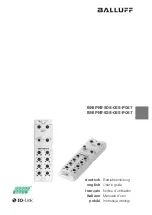
also available in a variety of sizes, and are listed in
Appendix II
as well. Electromotive can custom-make
trigger wheels in nearly any configuration for a one-time tooling fee.
To choose the proper size trigger wheel, find the diameter of the pulley or damper on which the
wheel is to be mounted. The trigger wheel diameter should be about ½” larger than this diameter. It should
also be noted that the trigger wheel should be at least ¼” from any moving magnetic pieces, such as bolts
or other fasteners, to avoid interference and false triggering. It is important that the trigger wheel be
perfectly concentric with the crankshaft centerline. To achieve concentricity, a shallow cut can be
machined in the front or rear face of the damper to create a centering ledge, and a hole can be created in the
trigger wheel to match the ledge diameter. The trigger wheel can then be drilled to bolt it to the damper.
See
Table A.4.1
below to determine the tolerances that must be maintained when mounting the
trigger wheel. These tolerances may require the use of a lathe to true the trigger wheel with the crankshaft
centerline, which can be accomplished by putting the entire damper/trigger wheel assembly on the lathe.
Note that the maximum out-of-round is the distance between the lowest and highest teeth and the crank
sensor. That is, if a feeler gauge is used between the sensor and the wheel to measure the out-of-round, the
reading between the lowest and highest teeth should not exceed the guidelines in the table.
Table A.4. 1:
Crank Trigger Specifications
Trigger
Wheel
Size
Air Gap
Maximum
Out-of-
Round
2.5" 0.025"
max 0.002"
3.5" 0.035"
max 0.003"
5" 0.050"
max
0.005"
6" 0.060"
max
0.006"
7.25" 0.070”
max 0.007"
8.25" 0.080”
max 0.008"
A.4.b. Magnetic Crank Sensor Installation
When installing the magnetic sensor, an appropriate bracket must be made to aim the sensor at the
trigger wheel. A good starting point for a magnetic sensor bracket is Electromotive part number 210-
72003, which is our universal sensor bracket (
See Figure A.4. 1
). If this part is not used as a starting point,
a custom bracket can easily be made.
The most important things to remember when fabricating a
bracket are that it should be bolted directly to the engine block, away from rotating steel or magnetic
pieces, and should be nonferrous (not attracted to magnets).
This will keep the sensor and trigger
wheel vibrating together so the gap between the two always
stays the same. Variations in sensor gap may cause erratic
timing or false triggering of the ignition. (This is the reason
for not mounting the trigger wheel to the outer ring of a
harmonic damper.) As such, any custom magnetic sensor
bracket should be very rigid. The sensor can be secured with
either a set screw or a clamping arrangement, as long as the
1/2” sensor is utilized (part number 250-72218). If the smaller
3/8” sensor is utilized, a clamping arrangement should be
employed rather than a setscrew, as the setscrews may crush
the sensor. See
Table A.4. 2
for the appropriate magnetic
sensor/trigger wheel combinations.
Fig A.4. 1:
Universal Crank
Sensor Bracket
______________________________________________________________________________________
TECgt Manual Version 2.0
- Page 13 -
©2008 Electromotive, Inc.














































